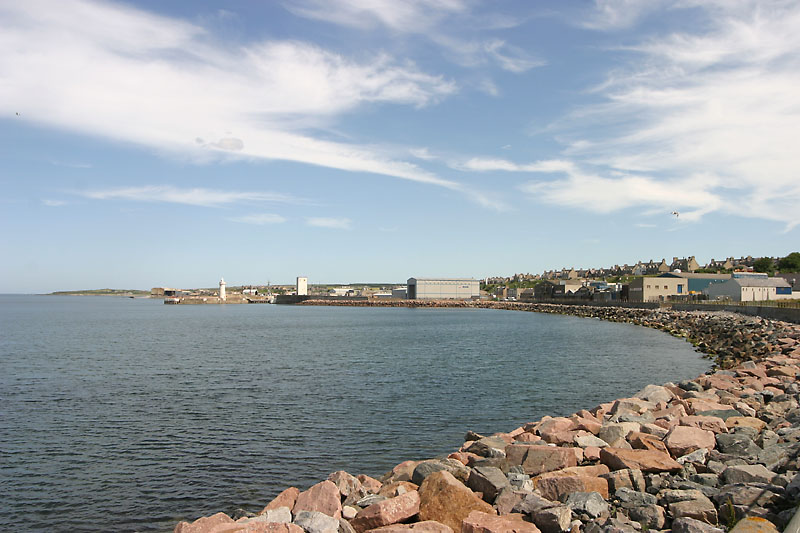Buckie
Lying just 13 miles from Elgin, Buckie was once a major fishing port and the largest town in the Banffshire region of Scotland. Buckie still serves as a port and boats continue to land their catch at Cluny Harbour as they have for centuries. However while fresh fish can still be bought at the market, food processing and packing has largely taken over as the main industry here.
The fishing village of Buckie stretches for some 3 miles along the Moray Firth coastline. Buckie was once a series of little fishing villages which merged over the years to become one community with different suburbs. In the mid nineteenth century, Buckie was served by a harbour at Nether Buckie constructed by that great engineer, Robert Stevenson and funded by the Cluny family. This first harbour suffered silting problems and the Cluny's second attempt, Cluny Harbour was worth all the effort. It took three years to build, cost 60,000 pounds and was the finest harbour to be found in the northeast of Scotland. Buckie went on to thrive as a harbour and would also become known for shipbuilding. This tradition is maintained today by the continuing construction and restoration of lifeboats at Buckie Shipyard.
The earliest settlement at Buckie was known as the "Shore of Buckie" and was located at the mouth of the Buckie Burn. As late as 1823 there were only three houses to be found in the conservation area now known as "Yardie". Stretching from the Buckie Burn to the Neuk, every possible inch of land here was arable and was used to grow subsistence crops such as kale. These were divided into plots for the fishermen and it is from these divisions that the area came to be known as the Yardie. Although now partially built up, in this area of Buckie you'll find the type of architecture which was typical to the sea towns of the Moray Coast. If you tour this coastline and other villages such as Pennan and Gardenstown, you'll see that houses were built with their gable end facing the sea to bear the brunt of the wind in stormy weather. Buckie's architecture from the mid 19th century onward was far more haphazard. Initially, stone used in construction of houses was brought from the Buckie coastline and low structures, (known as 'but and ben') consisting of two apartments topped with thatched roofs were typical here.
The tourist attractions in Buckie are largely related to the sea. In Clunie Place is the Buckie District Fishing Heritage Museum which along with the Buckie Drifter on Freuchny Road details the history of the fishing industry in Buckie and along the Morayshire coast. Art lovers can visit the library in Buckie for the Peter Anson Gallery which has a collection of Peter Anson's maritime paintings. Walkers in Buckie can head off on the Speyside Way, one of the four official long distance routes in Scotland. The route runs from Buckie to the edge of the Grampian Mountains. Golfers are also well-situated in Buckie and can play an 18 hole course at the Strathlene Golf Club with beautiful views of the Moray Firth.
The fishing village of Buckie stretches for some 3 miles along the Moray Firth coastline. Buckie was once a series of little fishing villages which merged over the years to become one community with different suburbs. In the mid nineteenth century, Buckie was served by a harbour at Nether Buckie constructed by that great engineer, Robert Stevenson and funded by the Cluny family. This first harbour suffered silting problems and the Cluny's second attempt, Cluny Harbour was worth all the effort. It took three years to build, cost 60,000 pounds and was the finest harbour to be found in the northeast of Scotland. Buckie went on to thrive as a harbour and would also become known for shipbuilding. This tradition is maintained today by the continuing construction and restoration of lifeboats at Buckie Shipyard.
The earliest settlement at Buckie was known as the "Shore of Buckie" and was located at the mouth of the Buckie Burn. As late as 1823 there were only three houses to be found in the conservation area now known as "Yardie". Stretching from the Buckie Burn to the Neuk, every possible inch of land here was arable and was used to grow subsistence crops such as kale. These were divided into plots for the fishermen and it is from these divisions that the area came to be known as the Yardie. Although now partially built up, in this area of Buckie you'll find the type of architecture which was typical to the sea towns of the Moray Coast. If you tour this coastline and other villages such as Pennan and Gardenstown, you'll see that houses were built with their gable end facing the sea to bear the brunt of the wind in stormy weather. Buckie's architecture from the mid 19th century onward was far more haphazard. Initially, stone used in construction of houses was brought from the Buckie coastline and low structures, (known as 'but and ben') consisting of two apartments topped with thatched roofs were typical here.
The tourist attractions in Buckie are largely related to the sea. In Clunie Place is the Buckie District Fishing Heritage Museum which along with the Buckie Drifter on Freuchny Road details the history of the fishing industry in Buckie and along the Morayshire coast. Art lovers can visit the library in Buckie for the Peter Anson Gallery which has a collection of Peter Anson's maritime paintings. Walkers in Buckie can head off on the Speyside Way, one of the four official long distance routes in Scotland. The route runs from Buckie to the edge of the Grampian Mountains. Golfers are also well-situated in Buckie and can play an 18 hole course at the Strathlene Golf Club with beautiful views of the Moray Firth.
